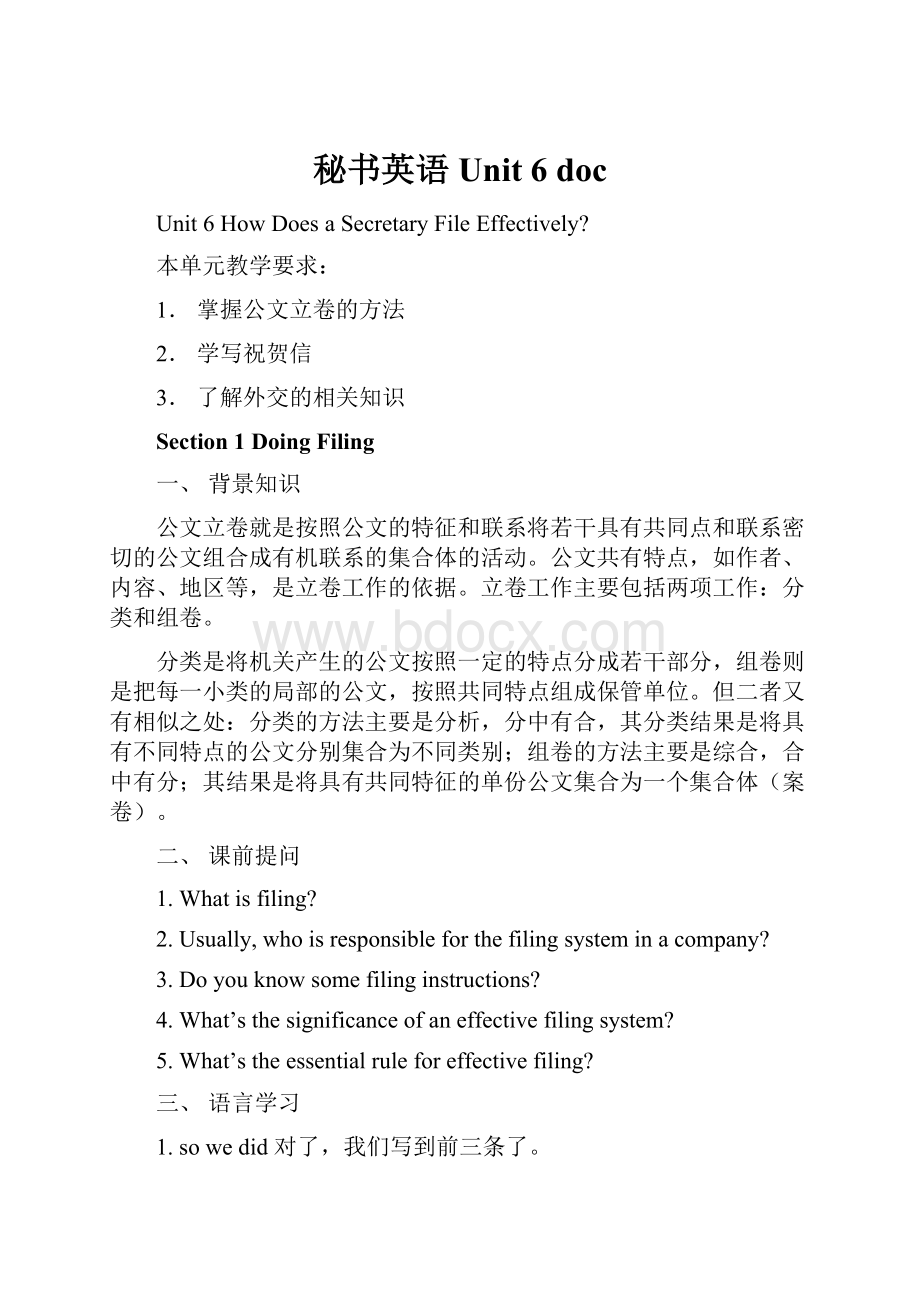秘书英语Unit 6 doc.docx
《秘书英语Unit 6 doc.docx》由会员分享,可在线阅读,更多相关《秘书英语Unit 6 doc.docx(28页珍藏版)》请在冰豆网上搜索。

秘书英语Unit6doc
Unit6HowDoesaSecretaryFileEffectively?
本单元教学要求:
1.掌握公文立卷的方法
2.学写祝贺信
3.了解外交的相关知识
Section1DoingFiling
一、背景知识
公文立卷就是按照公文的特征和联系将若干具有共同点和联系密切的公文组合成有机联系的集合体的活动。
公文共有特点,如作者、内容、地区等,是立卷工作的依据。
立卷工作主要包括两项工作:
分类和组卷。
分类是将机关产生的公文按照一定的特点分成若干部分,组卷则是把每一小类的局部的公文,按照共同特点组成保管单位。
但二者又有相似之处:
分类的方法主要是分析,分中有合,其分类结果是将具有不同特点的公文分别集合为不同类别;组卷的方法主要是综合,合中有分;其结果是将具有共同特征的单份公文集合为一个集合体(案卷)。
二、课前提问
1.Whatisfiling?
2.Usually,whoisresponsibleforthefilingsysteminacompany?
3.Doyouknowsomefilinginstructions?
4.What’sthesignificanceofaneffectivefilingsystem?
5.What’stheessentialruleforeffectivefiling?
三、语言学习
1.sowedid对了,我们写到前三条了。
so用于强调,置于句首,构成“so+主语+be动词、助动词”的排列,表示同意对方的话;比如:
–Heisthebeststudentinthisclass.
–他是班上最好的学生。
–Yes,soheis.
–他的确是。
so置于句首,构成倒装句式“so+be动词、助动词+主语”表示“……亦如此,……也一样”。
比如:
He’sateacherandsoishiswife.
他是位教师,他妻子也是。
2.inchronologicalorder按时间顺序。
in…order=inorderof…按…顺序:
inalphabeticalorder按字母顺序排列;arrangedinorderofsize,merit,importance,etc按大小、功绩、重要性等排列的
3.underthenameof用…作名字。
HewritesunderthenameofNimrod.它用尼姆罗德这个名字写作。
Insteadofusinghistruename,hesentthearticletothepaperunderthenameofSaki.
他不用真名,而用"沙奇"这个名字向报纸投稿。
4.catchup
1)赶上。
Theystartedafewminutesago,andwemusthurrytocatchup.他们几分钟前已出发,我们必须赶紧追上。
2)很快拾起。
Thethiefcaughtupthemoneyandranaway.小偷一把抓起钱,逃之夭夭。
3)缠住。
Itseemedthatshewasalwayscaughtupinthehousehold.看来她总是家务缠身
5.sothat为了如此...以至于;以便。
Sheworkedhardsothateverythingwouldbereadyby6o’clock.他拼命干以便能到六点时把一切都准备好。
so…that为的是;以便。
Hehassoorganizedhislifethathiswifesuspectsnothing.他把生活安排得井井有条,为的是不让妻子有任何怀疑。
6.onyourown你自己(完成)。
onone’sown独自。
Ican'tcarryitonmyown;it'stooheavy.我无法独自携带它,太重了。
相关的词组ofone’sown自己的。
Shehasamindofherown.她颇有主见。
7.attheendoftheday把一切都考虑进去:
Attheendofthedaythenewmanagerisnobetterthanthepreviousone.从各个方面来看,这位新经理并不比前任强。
四、参考答案
III.FurtherExercises
1.Restudythedialogueandbrieflyanswerthequestionsaboutit.
1)Whatarethetwospeakersdoing?
Theyarediscussinghowtofileeffectively.
2)Howmanypointshavetheyfinished?
They’vefinishedthefirstthreepoints.
3)What’sthefourthinstruction?
Itis“Beconsistent.Alwaysfilelettersfromthesame
customerinthesamefile.”
4)What’sthefifthinstruction?
Itis“Fileunderthenameofthefirmorjob,notunderthenameofthepersonyouarewritingto.”
5)DidMr.LingYuntellZhangYiwhentotransferoldmaterial?
No,hedidn’t.Heaskedhertodoitonherown.
6)WhatshouldZhangYiremembertodoattheendoftheday?
Sheshouldremembernottoforgettoincludeanoteonlockingthefilecabinetsattheendoftheday.
2.TranslatethefollowingdialogueintoChineseandlookatthediscforasuggestedversionofeach..
A:
Whatarethesefoldersfor?
A:
这些文件夹是做什么用的?
B:
Client’saccounts.Theirnamesarewrittenonthisprojectingedgeortab.Theyareindexedproperlyandkeptinthefilingcabinetsinaverticalposition.
B:
客户的账目。
他们的名字写在文件夹的凸出边沿或者标签上,把它们编上索引,垂直地放在文件柜里。
A:
Whatdothedifferentcolorcardsindicate?
A:
这些不同颜色的卡片表示什么?
B:
Thedifferentcolorsindicatewhichcommoditiesaresold.
B:
颜色表示所出售的商品是什么。
A:
Arethesefiledalphabetically?
A:
这些是按照字母顺序整理的吗?
B:
Exactly.You’llfindthatallthecardsforagivenclientaregroupedtogether.Inadditiontohelpingthesalesclerkwithhisstatements,you’llalsotakechargeoftheinvoicefiles,whichfollowthesamesystemastheindividualcards.
B:
是的。
你会发现,一位既定客户的所有卡片都归在一起。
除了帮助销售人员作结算单外,你还需要负责发票文件。
发票和个人卡片使用同样的系统。
A:
Thatgreatlysimplifiestheprocedure.Howdoyounumbertheinvoices?
A:
这样手续就简化多了。
您怎样给发票编号呢?
B:
Well,thenumberofinvoices—peryearforanyonecommodityisgenerallylessthanthreethousand,sowenumberbylotsofthreethousand.
B:
哦,发票的编号—通常一种商品每年的数量小于三千,所以我们用许多三千来编号。
A:
Idon’texactlyunderstand.
A:
我不是很明白。
B:
Forexample,wenumbercommodityA,fromonetothreethousand,commodityB,fromthreethousandtosixthousand,andsoon.
B:
例如,对于商品A,我们从一编号到三千,对于商品B,从三千编号到六千,等等。
A:
Itsoundsverypractical.
A:
听起来很实用。
B:
Yes,anditgivesusanextrareferencecheckforanygiveninvoice.
B:
是的,这可以使我们对已有的发票再进行一次参考核对。
3.Completethefollowingdialogueandlookatthediscforasuggestedversionofeachandlistentoitsrecording.
A:
I’vegotthelisthere,Mr.LingYun.
B:
Whatlist?
A:
Thelistofpointsaboutfiling(有关立卷的要点列表)—yousaidwewoulddiscussitthismorning.
B:
Oh,yes.Iremember.IwassocrossyesterdaywhenIdiscoveredthatEmmawaskeepingtwoseparatefilesforthesamecustomer(给同一个客户立了两个档案).
A:
Yes,yousaidwewouldhavetoissuealistoffilinginstructions(发布一份立卷须知)toallthestaffonfilingroutine.
B:
Right.Well,whathaveyouwrittendown?
A:
Well,IthoughtwemightheadthepageNOTICEandcenterthetitleFILINGINSTRUCTIONS(把标题“立卷须知”放在中间).
B:
Yes,that’sallright,andthenitcanbedatedattheendandsignedbythemanagingdirector(由总经理来签字)。
A:
Yes.
五、课文译文(原来就有译文。
)
A:
张一,咱们把立卷须知弄完吧。
B:
好的,这是一份咱们昨天写的东西。
A:
让我看看,咱们写到哪里了?
B:
咱们已经写完前三条了。
A:
对了,咱们写完前三条了。
让我来重温一下……(念)
1.文件要按时间顺序入卷。
2.除去曲别针和大头针。
必须放在一起的文件要用订书机订好。
3.卷内文件要整齐。
B:
很好,那么,下面一条是什么?
A:
第四条我写的是“要前后一致”。
B:
对,这很重要。
“一户一卷”是立卷的规矩。
A:
还有一条好规矩是----“按工作岗位立卷,而不是按从事该工作的人的姓名立卷。
”
B:
是的,很好。
人会改换工作,但公司的工作岗位一般是不会变的。
A:
就是这个意思。
给总会计师的信笺必须放在为总会计师立的C卷里,而不能放入为波卡先生立的P卷里,在波卡先生之前担任总会计师的是爱威特先生……
B:
是啊,谁会想到在E卷里找总会计师的文件呢?
A:
正是这样。
这样第四和第五条须知就都有了,是吧?
B:
是的。
第四条是:
“要前后一致,同一个客户的来信要放在同一个卷内。
”
A:
好。
下面你可以写上第五条,“按公司的名称或者工作岗位的名称入卷,而不是按照收信人姓名入卷。
”
B:
(以书写的速度慢慢地说)“……收信人姓名入卷。
”
A:
好的。
还有什么要写的吗?
B:
有,我还有几点,是关于使用相互参照便条和借出卡的问题,以及为了避免卷中文件放得太满,何时将旧资料转移的问题。
A:
这些我看你就自己写吧。
B:
很好,凌云先生。
A:
还有,别忘了加上一条,下班前必须锁好档案柜……
B:
是,我不会忘记的。
六、课文录音全文(Section1)
A:
NowZhangYi,let’sfinishdraftingthelistoffilinginstructions.
B:
Yes,here’sacopyofwhatwewroteyesterday.
A:
Letmesee,howfardidweget?
B:
We’vefinishedthefirstthreepoints.
A:
Yes,sowehad.Justletmerefreshmymemory…(reads)
1.Keepthedocumentsineachfileinchronologicalorder.
2.Removeclipsandpins.Papersthathavetobeattachedtogethershouldbestapled.
3.Placepaperssquarelyinthefiles.
B:
That’sfine.Nowwhat’sthenextpoint?
A:
FornumberfourI’vewritten“Beconsistent.”
B:
Yes,that’sessential.“Onecustomer—onefile”istherule.
A:
Andanothergoodruleistofilebyjobtitleandnotbythenameofthepersondoingthejob.
B:
Yes,ofcourse.Peoplechangetheirjobsbutthetitleusuallystaysthesame.
A:
Exactly.Sothatgivesusinstructionsfourandfive,doesn’tit?
B:
Yes.Numberfouris“Beconsistent.Alwaysfilelettersfromthesamecustomerinthesamefile.”
A:
Good.Andnowyoucanaddnumberfive,whichis“Fileunderthenameofthefirmorjob,notunderthenameofthepersonyouarewritingto.”
B:
(slowlyasshecatchesupwriting)…you’rewritingto.
A:
Right.Anythingelse?
B:
Yes,I’veafewpointsabouttheuseofcross-referenceslipsandOUTcardsandwhentotransferoldmaterialsothatthefilesdon’tbecometoocrowded.
A:
Well,Ithinkyoucanfinishthoseonyourown.
B:
Verywell.Mr.LingYun.
A:
Anddon’tforgettoincludeanoteonlockingthefilecabinetsattheendoftheday.
B:
No,Iwon’tforget.
Section2FilingEffectively
一、背景知识
公文的分类应该符合分类的逻辑原则,力求简明、严密。
每一种分类层次只能使用一种分类标准,也就是,将一大组公文划分成若干小组时,只能使用一个相同的标准,不允许同时使用几种标准。
通常,机关公文分类可以划分为四个层次:
分年度、分组织机构、分问题、分保管期限。
公文组卷,即对分类后的各属类按照其共同特征和主要联系,将其组合成一个个案卷的活动。
组卷的依据是从公文结构中概括出来的作者、问题、时间、名称、通讯者、地区等诸要素,它们体现了公文在这些方面特有的联系及形成规律。
二、课前提问
1.Whatshouldbeincludedinafile?
2.Ifyouareasecretary,whatwillyoudotoeachfilewhileyouarefiling?
3.Whatarebasicrequirementsforafilingsystem?
4.Howwillagoodfilingsystemaffectthewholeorganization?
5.Doyouknowsomeuniversallyusedcommandmentsforfilingmanagement?
三、语言学习
1.neither…nor…既不...也不...。
NeithershenorIknew.她和我都不知道。
2.uptodate最新的(作表语)。
Allthedataareuptodate.所有的数据都是最新的。
up-to-date(作表语或定语):
1)最新的;包含最新信息的:
anup-to-datereport有关最新情况的报告
2)时新的;新式的;现代的
anup-to-datefactory一座现代化的工厂
Tonyismoreup-to-datethanI.托尼比我更新潮。
3.heapup积成堆,堆起来。
Garbageheapedupbehindthehouse.屋后垃圾积成了堆。
heapupstonestoformadam把石头堆成一道堤坝
heapupriches积聚财富
4.everynowandthen时常;有时。
Shecomestovisituseverynowandthen.她时常来看望我们。
5.dependupon=dependon
1)视某事物而定;取决于某事物:
Alotwilldependonhowsherespondstothechallenge.在很大程度上将取决于她对这一难题的反应。
Howmuchisproduceddependsonhowhardwework.产量的大小就在我们努力的程度。
2)依靠;信赖。
She’sawomanwhocanbedependedon.她是个可以信赖的人。
3)确信;坚信;信赖:
Youcanneverdependonhisarrivingontime.绝不可指望他能准时到。
6.carryout实现。
Shehadfinallycarriedoutherpromisetoquitsmoking.她最终实现了戒烟的诺言。
7.bear/keepsb./sth.inmind记住某人[某事物]。
Wehavenovacanciesnow,butwe’llcertainlybearyourapplicationinmind.我们目前没有空缺,但是我们一定记住你申请的事。
bearinmindthat…记住。
Bearinmindthatyou'llhavetopracticeeconomy.记住要厉行节约。
8.either…or…不是...就是...;要么...要么...。
Sheiseitherdrunkormad.她不是醉了就是疯了。
四、参考答案
III.FurtherExercises
1.Restudythepassageandbrieflyanswerthequestions.
1)Whatistheessenceoffiling?
Itistobringtogetherinasinglefolderorfileallpapersrelatingtoaparticularpersonorsubjectandthatlettersreceivedarefiledwiththosesentinreply.
2)Whatshouldafileinclude,besidescorrespondence?
Besidescorrespondence,itmustincludetelegrams,notesofimportantinterviews,decisionsatmeetings,telephonemessages,andanyothermattersneeded
3)Howisfilingrelatedtobusiness?
Filingisanessentialpartofanybusinessanditaffectsthewholeorganization.Aninefficientsystemisfrustratingtoeveryoneconcerned.
4)Givethreemerits,atleast,toshowagoodfilingsystemwillhave.
Agoodfilingsystemwill,atleas